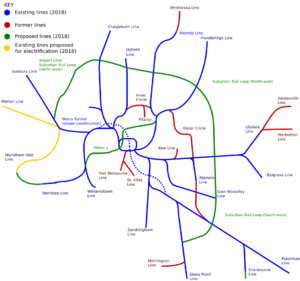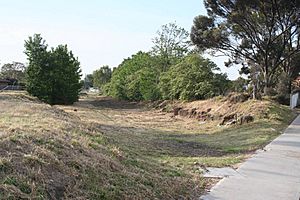Outer Circle railway line facts for kids
Quick facts for kids Outer Circle |
|
|---|---|
| Overview | |
| Status | Part retained as the Alamein line; Chandler Highway; otherwise parkland |
| Connecting lines | Hurstbridge, Lilydale, Pakenham and Cranbourne lines |
| Service | |
| Type | Melbourne suburban service |
| History | |
| Opened | 30 May 1890 |
| Closed | 4 April 1893 |
| Technical | |
| Number of tracks | Single track |
The Outer Circle was an old railway line built in Melbourne, Australia, way back in 1891. It was designed for steam trains to carry people around the city's outer areas. This line went through many parts of what is now the City of Boroondara. This includes suburbs like Kew East, Camberwell, Burwood, Ashburton, and Malvern East. At its longest, the Outer Circle stretched from Fairfield station to Oakleigh station. Today, parts of it are still used, like the Alamein line. Other parts have become bike paths or roads.
Contents
History of the Outer Circle Railway
The idea for the Outer Circle railway started a long time ago. In 1867, a group called the Upper Yarra Railway League first suggested it. They thought the Gippsland Railway could reach Melbourne through the outer suburbs.
The actual name "Outer Circle route" was first used in 1873. It came from Thomas Higinbotham, a chief engineer for the Victorian Railways.
Why the Outer Circle Was Built
Building the Gippsland line was approved in 1873. But there was a problem: trains couldn't go directly into Melbourne. A private company owned the tracks from Flinders Street station. Also, there was no connection between Flinders Street and Spencer Street stations.
By 1879, these issues were solved. The direct railway opened, and the government bought the private railway company.
The next push for the Outer Circle line came from politics and land investors. These investors bought land hoping its value would increase. The line was included in railway building plans in 1882 and 1884. The law to build the line passed on December 12, 1884. This law also approved a bridge to connect Flinders Street and Spencer Street stations.
By 1885, two politicians who helped approve the line had bought a lot of land next to it. They were F.E. Beaver and James Munro.
Building the Railway Line
Construction of the Outer Circle began in 1888. It was finally finished by 1891. The line connected Camberwell station to Oakleigh station in the south. It passed through Riversdale. The last part built was north from Riversdale to Fairfield station.
There was also a smaller branch line. It went from the closed Waverley Road station to Darling and Burnley. This branch opened a few weeks before the main Outer Circle line. Today, this is part of the Glen Waverley line.
When it opened, the line was about 16.6 kilometers long. It had 11 stations, each with two platforms. The line was built to allow for two tracks, even though only one was laid. Stronger rails were used, weighing 75 pounds per yard. However, the line never carried Gippsland train traffic. An economic downturn in the early 1890s also stopped new homes from being built.
Train Services on the Outer Circle
The first part of the Outer Circle opened on March 24, 1890. This section ran from Oakleigh to Waverley Road, and then to Burnley. The line from Waverley Road to Camberwell opened on the same day. The Riversdale to Fairfield Park section opened on March 24, 1891.
From then on, the line ran as three separate passenger services:
- Oakleigh to Burnley (passengers changed at Waverley Road).
- Waverley Road to Camberwell (passengers changed at Riversdale).
- Riversdale to Fairfield Park.
Changes to Services
Not many people used the trains, so services were cut. The Riversdale to Fairfield Park section closed on April 12, 1893. A horse bus service replaced it. The Oakleigh to Ashburton and Darling section closed on December 9, 1895. The last section from Camberwell to Ashburton closed on May 1, 1897.
However, the Camberwell to Ashburton section reopened on July 4, 1898. A steam locomotive with a single carriage ran on it. The northern section from Riversdale to Deepdene reopened on May 14, 1900. A steam train, known as the Deepdene Dasher, ran every 90 minutes. It connected at East Camberwell. The Deepdene Dasher was the last passenger steam train in suburban Melbourne.
Electrification and Modern Lines
Work to electrify Melbourne's railway network began in the 1920s. In 1923, railway officials decided not to electrify the line from Deepdene to Ashburton. They thought there weren't enough passengers. But they soon changed their minds.
The Camberwell to Ashburton section was included in the project. The last steam train ran on October 29, 1924. Electric trains started running three days later. They ran every 40 minutes, connecting at Camberwell.
On August 15, 1926, the last steam-hauled Deepdene Dasher ran. It was replaced by two AEC railmotors. Officials planned to electrify this line if more people used it. But traffic didn't increase. So, on October 10, 1927, a road bus replaced the train service. The electrified suburban service from Camberwell to Ashburton is now known as the Alamein line.
Goods trains also used the line. They initially went to Ashburton and some to Deepdene. These services were extended to East Kew on February 11, 1925. Goods services continued until September 6, 1943.
The Outer Circle Today
Today, the southern part of the line is still used. The section from Camberwell to Alamein is part of the Melbourne suburban railway network. It is known as the Alamein line.
The northern part of the line, starting at East Camberwell, has been changed. It is now the Outer Circle Trail. This is a popular path for walking and cycling.
All the old, closed stations have been taken down. Most of the railway tracks and other structures are gone too. However, some road bridges that went over or under the railway still remain. The old rail bridge over the Yarra River was turned into a road bridge. This happened sometime after 1919 and is now part of the Chandler Highway.
The track between Fairfield station and the Yarra River was used from 1919. It became the APM Siding, serving a paper mill built there.
Media About the Outer Circle
In 2014, a documentary film was made about the Outer Circle. It was called Melbourne's Forgotten Railway - The Outer Circle. A Melbourne team led by Ron Killeen and Andrew McColm produced it.
The film explored the history of the line. It featured historians and urban planning experts. It also included people who remembered seeing and riding on the train.
Line Guide





